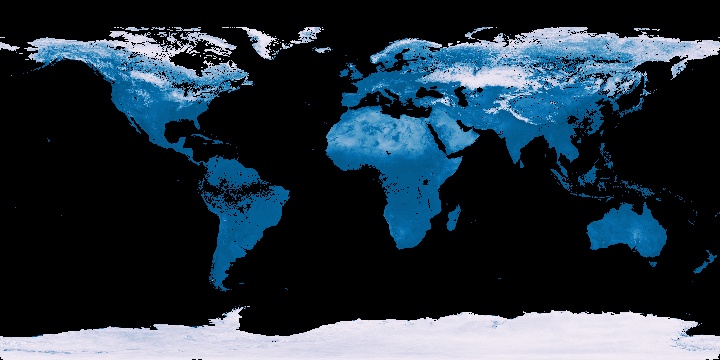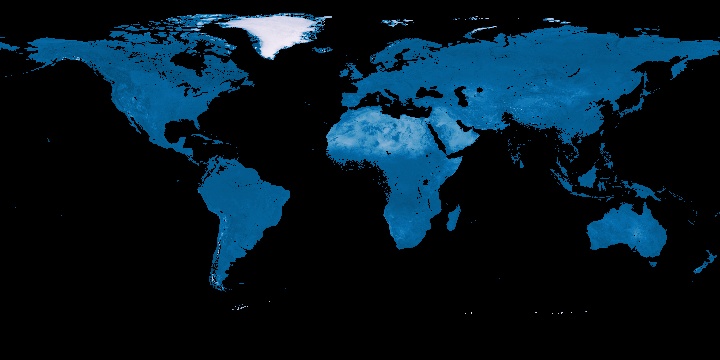Albedo

Albedo is the amount of solar radiation that is reflected by some surface, and is often expressed as a percentage or a decimal value. Overall, albedo is a measure of the reflectivity of the surface of the Earth.[2] White objects, such as a snowy hill have a high albedo. Conversely, dark objects like pavement have a low albedo.[3] Because of this, part of energy efficient building design is taking into consideration whether a wall or ceiling warms the building or keeps it cool - resulting in a choice of a dark or light coating respectively.
The albedo on Earth can vary slightly. Changes in albedo occur as a result of varying degrees of cloudiness as well as the amount of cloud cover, snow, ice, and vegetation that exist in a given area. Since it is one of the major properties that controls how much energy reaches the surface of the Earth, it is an important factor in climate models. In addition to describing the properties of an object, such as its colour, the albedo can provide information about the land surface, including soil moisture, amount of vegetation, and levels of urbanization.
It is important to note that the surface doesn't have a single albedo, rather a number of different albedos that are combined into a single number to accurately describe how the Earth reflects and absorbs solar energy as a whole. Figures 2 and 3 below illustrate that different albedos exist around the world, and these albedos can change depending on the time of year. For both images, high albedos are represented by the colour white while lower albedos are a dark blue.


Climate Change
The concept of albedo is important when investigating climate change. The overall albedo of the Earth - measured to be 0.30 - has a significant effect on the equilibrium temperature of the Earth as it changes how much solar energy is reflected by the Earth as opposed to how much is absorbed.[5] This changes how Earth's energy budget balances and thus changes Earth's heat balance.
Global warming is causing changes to the Earth's albedo. The amount of ice covering the planet is dropping as a result of increased temperatures from global warming. This causes a decrease in the area of white surfaces, leading less energy to be reflected and more to be absorbed. This process warms the Earth even more. The melting of Arctic ice is especially concerning as it triggers a positive feedback (a feedback cycle that drives the climate out of control). In addition to melting ice which lowers albedo, the conditions caused as a result of the greenhouse effect can also change the albedo of the Earth. The greenhouse effect can lower the albedo of the Earth by trapping in more infrared radiation with the increased number of greenhouse gases in the atmosphere, allowing less energy to bounce off of the atmosphere. Since the greenhouse effect can lower the albedo of the Earth and a changing albedo can result in a changing in the equilibrium temperature of the Earth, a change in albedo can contribute to climate change.[6]
For information on how the Earth's albedo is measured please see NASA's site, measuring the Earth's albedo.
References
- ↑ Wikimedia Commons. (September 26, 2015). Roof Albedo [Online]. Available: https://upload.wikimedia.org/wikipedia/commons/6/6a/Roof-albedo.gif
- ↑ ESR. (September 26, 2015). Albedo [Online]. Available: https://www.esr.org/outreach/glossary/albedo.html
- ↑ IPCC, 2012: Glossary of terms. In: Managing the Risks of Extreme Events and Disasters to Advance Climate Change Adaptation [Field, C.B., V. Barros, T.F. Stocker, D. Qin, D.J. Dokken, K.L. Ebi, M.D. Mastrandrea, K.J. Mach, G.-K. Plattner, S.K. Allen, M. Tignor, and P.M. Midgley (eds.)]. A Special Report of Working Groups I and II of the Intergovernmental Panel on Climate Change (IPCC). Cambridge University Press, Cambridge, UK, and New York, NY, USA, pp. 555-564.
- ↑ 4.0 4.1 NASA Earth Observatory. (September 26, 2015). Albedo [Online]. Available: http://neo.sci.gsfc.nasa.gov/view.php?datasetId=MCD43C3_M_BSA
- ↑ Measuring the Earth's Albedo, Accessed March 30th, 2019. https://earthobservatory.nasa.gov/images/84499/measuring-earths-albedo
- ↑ HyperPhysics. (September 26, 2015). Albedo of the Earth [Online]. Available: http://hyperphysics.phy-astr.gsu.edu/hbase/phyopt/albedo.html

